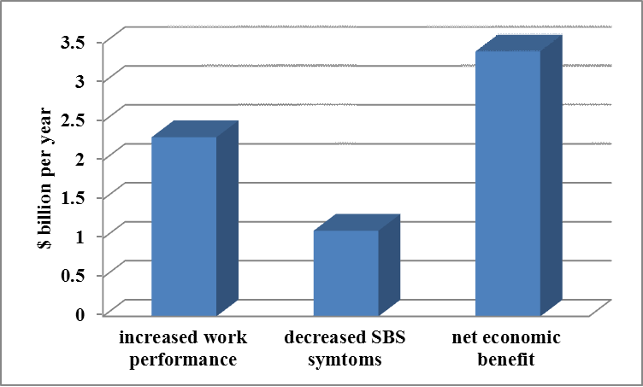Better Control of Indoor Temperatures
National Benefits of Better Control of Indoor Temperatures
Indoor temperatures affect thermal comfort [1], satisfaction with air quality [2], the fraction of workers who experience sick building syndrome symptoms [3, 4], and office and school work performance [5-7]. In practice, indoor temperatures are controlled to maintain thermal comfort. The ASHRAE Thermal Comfort Standard [1] defines comfort zones for winter and summer within which a majority of people are thermally comfortable. As discussed in the section of this web site on performance and productivity[1] , a statistical analysis of research findings indicates that performance of office work is maximized at a temperature of approximately 70 oF to 72 oF [5]. A more recent paper [8] provides a similar finding but with maximum work performance at approximately 73 oF. Given available data, one can assess the opportunity to improve comfort, symptoms, and performance by changing indoor air temperatures.
A survey of 100 U.S. offices buildings found that winter workday indoor temperatures were near the upper boundary of ASHRAE’s thermal comfort zone for winter during a significant fraction of the time [3]. Given information on how temperatures affect thermal comfort, work performance, and sick building syndrome symptoms, there is an opportunity to simultaneously improve thermal comfort, decrease sick building syndrome symptoms, and improve work performance by avoiding work-time temperatures in winter greater than approximately 73.4 oF in U.S. offices. Based on analyses of this opportunity [9], the estimated benefits include an average 0.2% increase in work performance in 40 million workers, an average 12% reduction in winter dissatisfaction with thermal comfort in 40 million workers, and prevention of 8 million cases of weekly sick building syndrome symptoms. The total estimated annual economic benefit is $3.4 billion (see Figure 3) with an annual implementation cost less than $0.4 billion. Energy costs for space heating would be reduced by an amount that was not quantified.
In the same survey, more than half of the measured workday indoor temperatures in summer fell below the lower bound of the ASHRAE thermal comfort zone for summer [3]. Given information on how temperatures affect thermal comfort, work performance, and sick building syndrome symptoms, both comfort and symptoms could be improved by avoiding indoor temperatures below 73.4 oF during the summer, but work performance would be diminished slightly. There is an opportunity to simultaneously improve comfort, sick building syndrome symptoms, and work performance by avoiding work-time indoor temperatures in summer below approximately 71 oF; however, this option has not yet been analyzed.

Figure 3. Estimated annual benefits of eliminating winter work time temperatures greater than 73.4 oF in U.S. offices. Not shown are thermal comfort improvements and energy savings for which no economic estimates are available, and annual implementation costs roughly estimated at less than $0.36 billion.
It has been demonstrated that the comfort level or air temperature has measureable impacts on heart rate, respiration, exhaled carbon dioxide concentrations, and mood and sick building syndrome symptoms, as well as work performance [6]. Whether it is temperature or the level of thermal comfort that directly affects work performance is a key unresolved question [6-8]. Temperature, clothing, activity level, humidity, and air motion all affect thermal comfort. If it is thermal comfort that directly affects work performance, there will be opportunities to maintain work performance with less energy consumption through adjustment of clothing levels and air movement. In particular, comfort in the summer can be maintained with significantly higher indoor temperatures through the use of fans to increase air velocities [1].
The reasons for frequent cases of poor control of indoor temperature in existing U.S. offices are not fully understood, but changes in temperature set points, calibration of thermostats, and adjustment of the balance of air supply to different rooms are expected common corrective measures. In the longer term, equipment that enables increased personal control of temperatures may be utilized. The estimated annual implementation cost for avoiding low winter-time temperatures, $0.4 billion, assumed that a full building retro-commissioning was required every five years in 50% of the office building stock [9]. True costs may actually be smaller, because many elements of typical retro-commissioning address problems other than poor indoor temperature control. Analyses indicate that retro-commissioning saves energy with a median payback of 1.1 years [10]; however, the energy cost savings have not been included among the benefits described in this web site.
4. Mendell, M.J., et al., Indoor particles and symptoms among office workers: results from a double-blind cross-over study. Epidemiology, 2002. 13(3): p. 296-304. https://dx.doi.org/10.1097/00001648-200205000-00010.
7. Wargocki, P. and D.P. Wyon, The effect of moderately raised classroom temperatures and classroom ventilation rate on the performance of schoolwork by children. HVAC&R Research, 2007. 13(2): p. 193-220. https://dx.doi.org/10.1080/10789669.2007.10390951.
8. Lan, L., P. Wargocki, and Z. Lian, Quantitative measurement of productivity loss due to thermal discomfort. Energy and Buildings, 2011b. 43(5): p. 1057-1062. https://dx.doi.org/10.1016/j.enbuild.2010.09.001.
10. Mills, E., Building commissioning: a golden opportunity for reducing energy costs and greenhouse gas emissions. 2009, Lawrence Berkeley National Laboratory http://cx.lbl.gov/2009-assessment.html: Berkeley, CA.